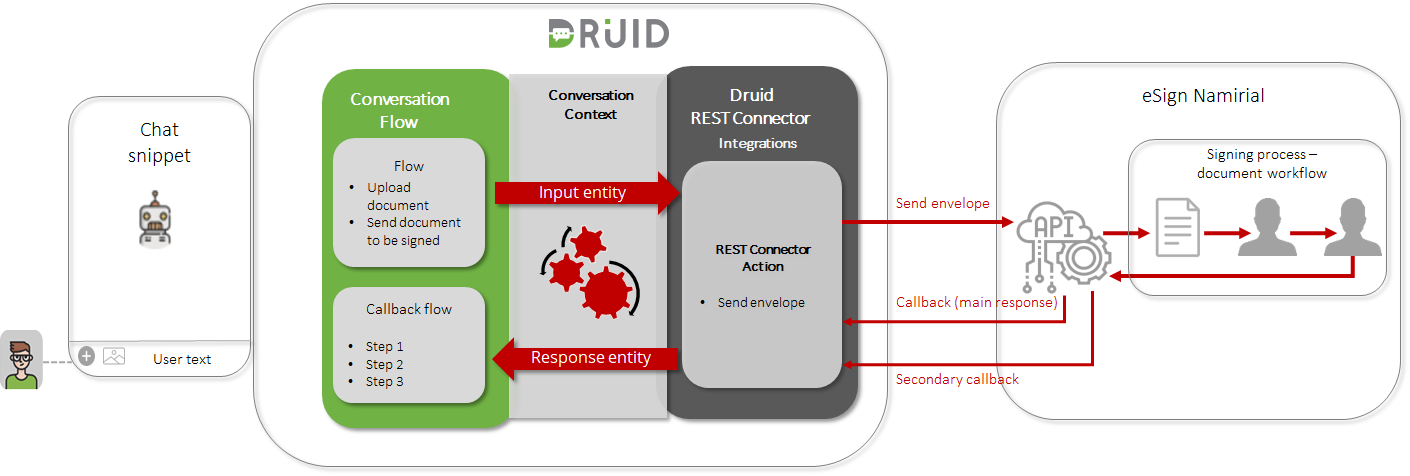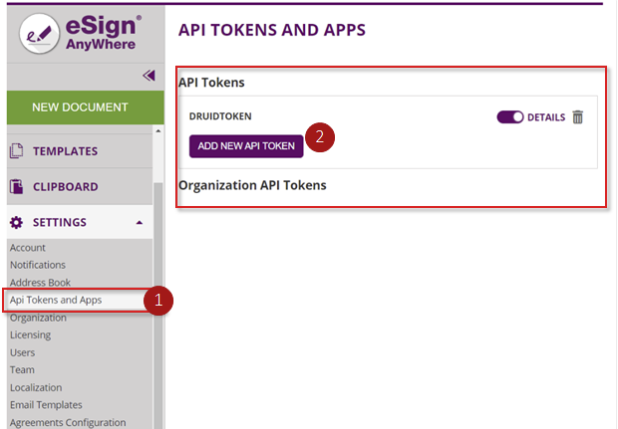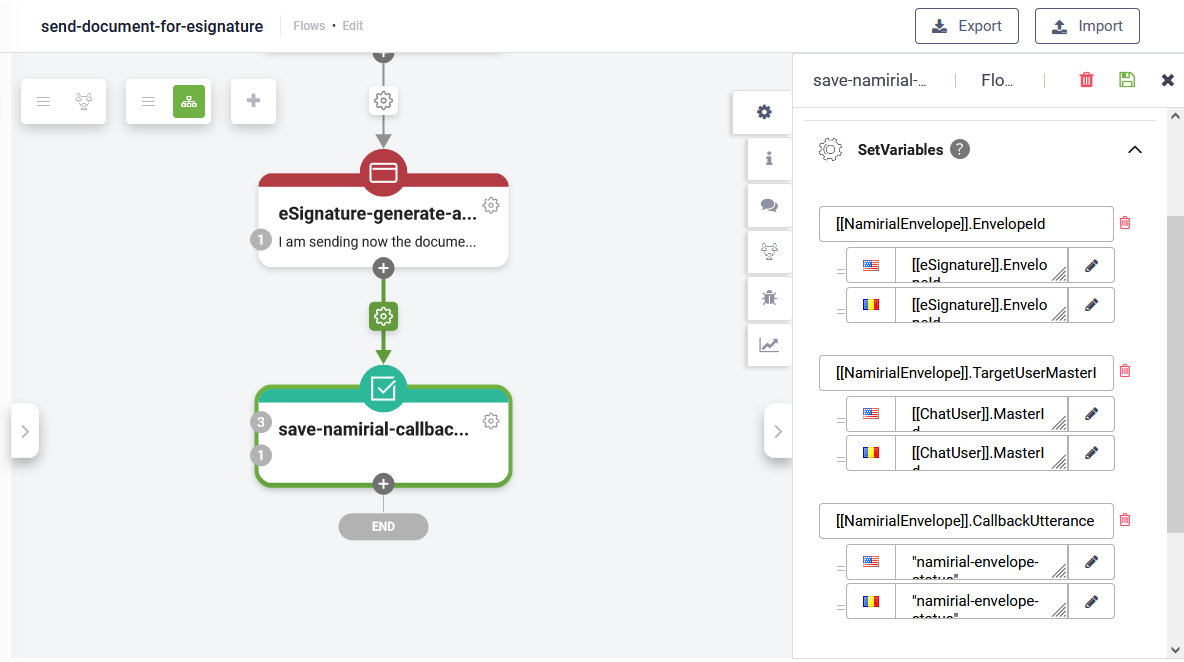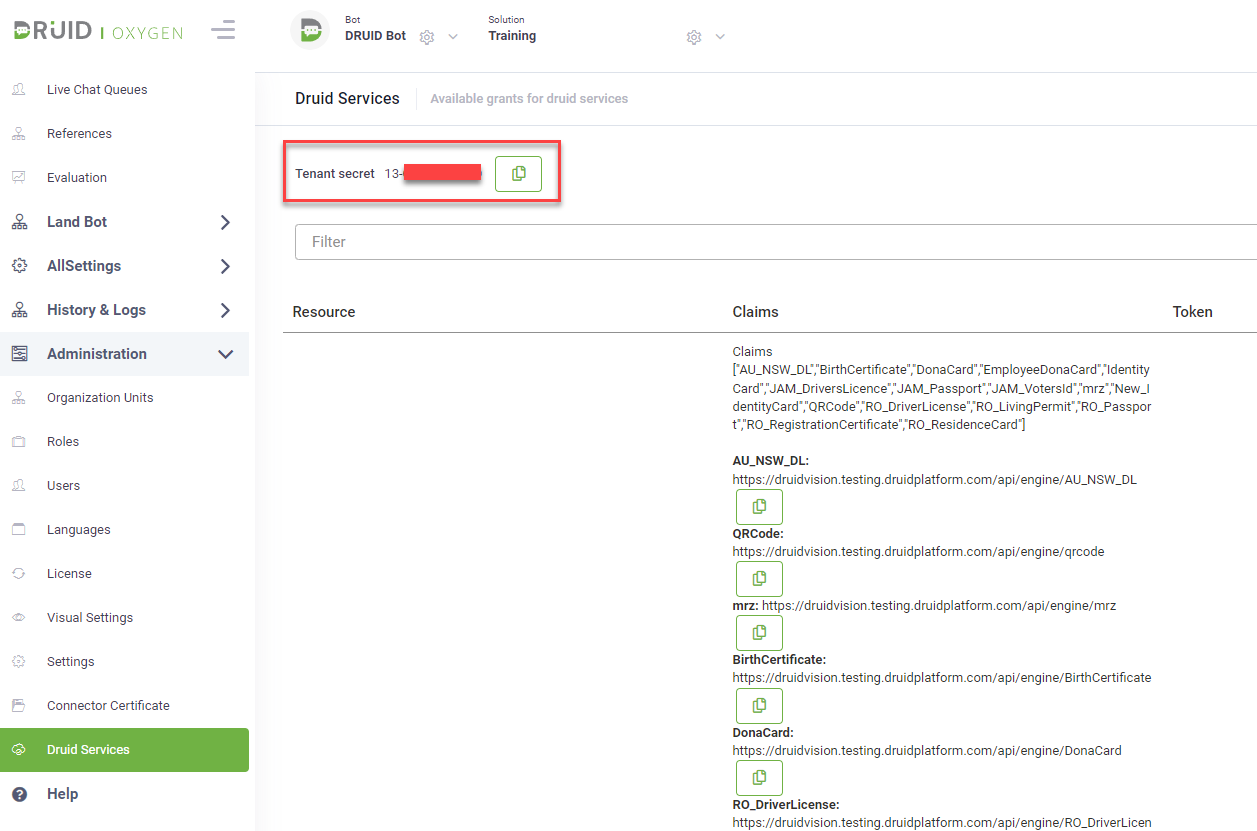eSign Namirial
You can use Namirial technology to provide your Druid chatbots with electronic signature capabilities, enabling users to apply electronic signatures on documents through Druid chatbots, in both office and work-from-home environments.
By integrating with eSign, the electronic signature of a digital document can be done through any Druid chatbot, in any scenario, such as: at the point of sale, at the point of service, mobile sales, customer onboarding, KYC, contract management, remote signing (employees working remotely or working from home), or internal document signing.
The chatbot will automatically apply to any document the electronic signature type specific to the internal flow, role and user rights (standard, advanced or qualified electronic signature). The digital documents are archived electronically, carrying advanced timestamps, in full compliance with Romanian, European and international laws.
To provide your chatbot with electronic signature capabilities, you need to set up a REST connector, which you will use for electronic signature of documents.
The figure below provides an overview on how you can use the eSign Namirial integration.
Prerequisites
- You need to have an eSign subscription with Namirial (either demo or production account).
- In Namirial Digital Transaction Management Platform, go to Settings > Api Tokens and Apps and generate a new ApiToken.
- In order to use the Namirial eSignature, you need a DruidNamirialToken generated for your tenant. To get one, contact Druid Tech Support. After Druid Tech Support confirms that a DruidNamirialToken was generated, you can see the token in the Druid Chatbot Portal. From the main menu, click Administration > Druid Services. Copy the token as you will need it during the connector setup.
Copy this API token, you will need it in Druid to authenticate the requests.
Step 1. Set the REST connection strings
Create connection strings following the generic procedure with the following particularities:
- Depending on your Namirial setup, in the URL field, enter https://saas.esignanywhere.net for production environment or https://demo.esignanywhere.net/Api for demo environment.
- In the Variables section, add the following:
- the API token you generated in Namirial.
- the DruidNamirialToken. Copy it from the Administration menu> Druid Services.
- the StatusUpdateCallbackUrl. When sending the file for signing (REST call), use the URL specific to the Druid Cloud you're using:
- Druid Cloud Community: https://comm-Druid-endpoints.azurewebsites.net/api/Namirial/StartFlow
- Druid Cloud Australia: https://prod-au-Druid-endpoints.azurewebsites.net/api/Namirial/StartFlow
- Druid Cloud West-Europe: https://prod-Druid-endpoints.azurewebsites.net/api/Namirial/StartFlow
Step 2. Add integration task to send document for signature
Make a POST request to /v5/envelope/send.
From the RequestType field, select UseBodyTemplate.
In the Body field, enter your request. This section provides useful information for making the request to send document for e-signature.
In the eSign Namirial integration, Druid supports three callback types:
- Envelope callback - The basic callback (“CallbackUrl”: “{{DruidBaseURL}}?Token={{DruidToken}}&envelope=##EnvelopeId##”), which is fired if the envelope reaches a final state (completed, rejected).
- Envelope status callback - Envelopes status callbacks (“StatusUpdateCallbackUrl”: “{{DruidBaseURL}}?Token={{DruidToken}}&envelope=##EnvelopeId##&action=##Action##”,) are fired, based on envelope events/actions:
- workstepFinished: when the workstep was finished
- workstepRejected: when the workstep was rejected
- workstepDelegated: when the workstep was delegated
- workstepOpened: when the workstep was opened
- sendSignNotification: when the sign notification was sent
- envelopeExpired: when the envelope was expired
- workstepDelegatedSenderActionRequired: when an action from the sender is required because of the delegation.
- Workstep Event callback - specific event callbacks ("StatusUpdateCallbackUrl": “{{DruidBaseURL}}?Token={{DruidToken}}&envelope=##EnvelopeId##&event=##EventType##”) fired on events caused by the underlying "SIGNificant Server Platform" component, but also routed through the notification system of eSignAnyWhere. These callbacks inform in a more detailed way about the workstep events - but note that those events are not necessarily time-synced to the envelope events. To trigger activities on the eSignAnyWhere API, always consider the envelope or envelope status callbacks.
Based on the type of callback you want to make, in the request body, provide the URL for the appropriate callback type in the following format:
“CallbackUrl”: “{{DruidBaseURL}}?Token={{DruidToken}}&envelope=##EnvelopeId##”, “StatusUpdateCallbackUrl”: “{{DruidBaseURL}}?Token={{DruidToken}}&envelope=##EnvelopeId##&action=##Action##” "WorkstepEventCallback": { "Url": “{{DruidBaseURL}}?Token={{DruidToken}}&envelope=##EnvelopeId##recipientEmail=##RecipientEmail##&recipientOrder=##RecipientOrder##", "WhiteList": ["string"] },
You can use additional information provided by the Workstep event callback in the main conversation or start a secondary conversation, as best suits your needs.
Use cases for triggering a secondary conversation:
- Another user (service account, usually) will update the same envelope ID information (returned by the callback) in a database or in a third-party system, without interfering with the main conversation.
- You want to inform a manager that the user has signed off a document, without interfering with the main conversation.
Click the Body tab and map DruidBaseURL and DruidToken to Druid local variables @DruidBaseURL and @DruidToken (which have been set on the app).
Save the integration task. Call it on the desired step of the flow where you send the document for signature.
Step 3. Save Namirial callback context
On the flow you created to send the document for signature, add as last step a step of type action on which you set the following variables:
- [[NamirialEnvelope]].EnvelopeId = [[eSignature]].EnvelopeId
- [[NamirialEnvelope]].TargetUserMasterId = [[ChatUser]].MasterId
- [[NamirialEnvelope]].CallbackUtterance = <the utterance of the flow you want to be trigger at callback, assuming you created that flow>
For Druid 1.67 or higher, if you want to trigger a second conversation to process information returned by the Workstep event callback, use secondary parameters available in the [[NamirialEnvelope]] system entity. For more information on the available entity fields, see System Entities.
In order for the callback to initiate a secondary conversation, you need to add the parameter “secondary=true” to the corresponding callback URL (to any of the 3 URLs which can be specified in the request: Callback URL, Status Callback URL or Workstep event callback URL).
For example: “{{DruidBaseURL}}?Token={{DruidToken}}&envelope=##EnvelopeId##recipientEmail=##RecipientEmail##&recipientOrder=##RecipientOrder##&secondary=true".
Additionally, all following metadata sent by Namirial callback can now pe mapped to Druid conversation context:
- workstepId=##WorkstepId## – workstep of current action
- eventType=##EventType## – type of event (see list of types below)
- source=##Source## – internal (eSAW) or external (Viewer)
- time=##Time## – time when the action occurred
- description=##Description## – textual description of the event
- recipientEmail=##RecipientEmail## – emailadress of current recipient
- recipientOrder=##RecipientOrder## – index of current recipient
In order to shorten the length of the URL when sending multiple callback parameters, you can replace the Token parameter with a much shorter authentication key : “secret”.
For example: “{{DruidBaseURL}}?secret={{DruidTenantSecret}}&envelope=##EnvelopeId##recipientEmail=##RecipientEmail##&recipientOrder=##RecipientOrder##&secondary=true"
The value for Druid Tenant Secret can be found in Druid portal -> Administration / Druid Services:
On this last step, in the Post actions section, call Druid Internal action SaveNamirialCallbackContext.
eSignature Namirial Solution Template
To simplify the bot authoring experience, go to Solutions Library and import the eSignature Namirial solution template. It contains:
- Namirial setup for two signers. The type of signature is Click2Sign with authentication via PIN Code.
- Sample conversation available in EN-US to collect data for the first and second signer (first name, last name, email address).
- Sample document template to be signed. If you want to use another document template, you should generate it from your Namirial organization.
- eSignAnywhere.Api V5 and full management of namirial-Druid integration services like: upload file to Namirial, generate file, get signature url, get envelope status or download documents.
For information on how to configure the solution template, see eSignature Namirial solution template.




